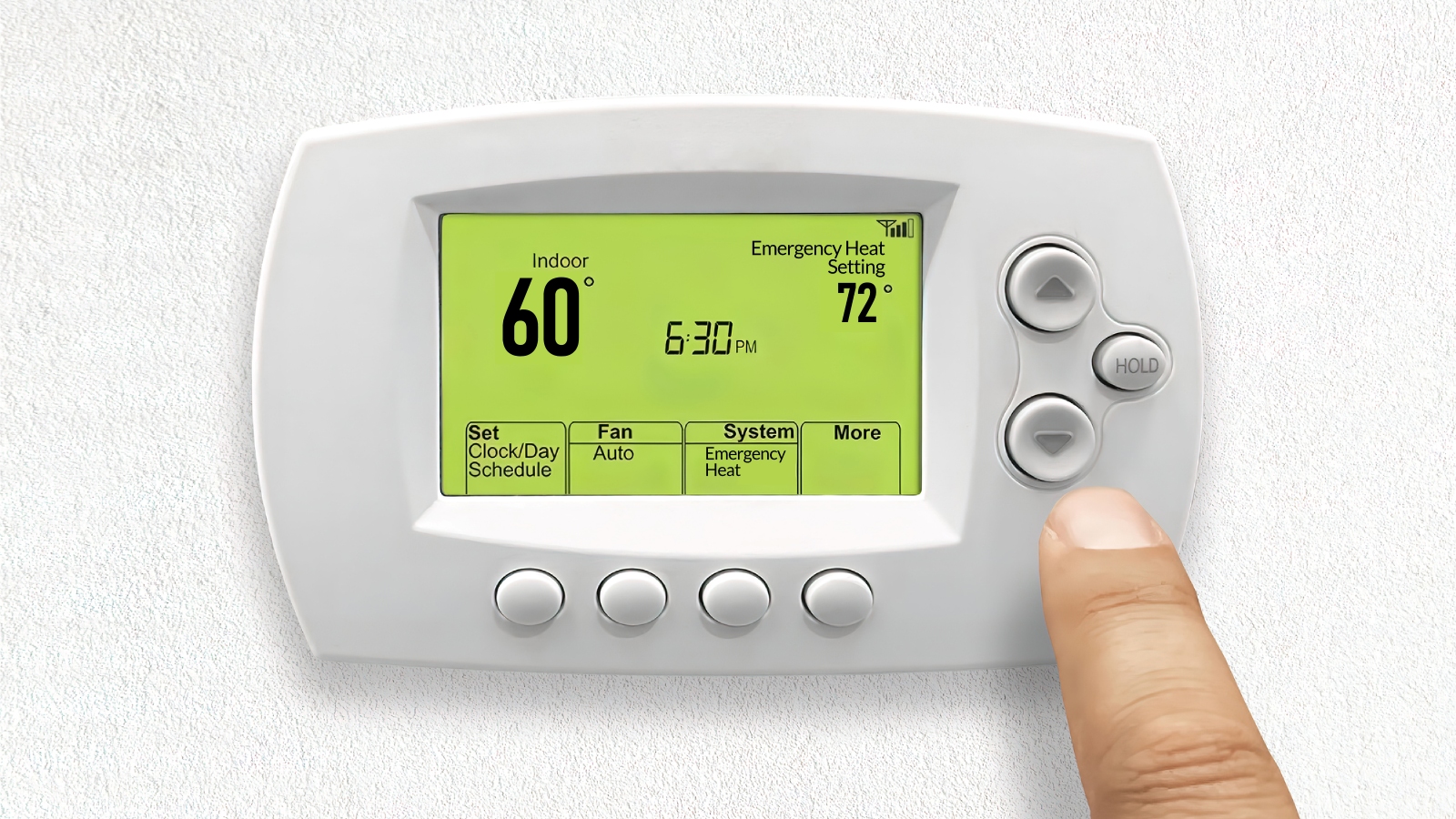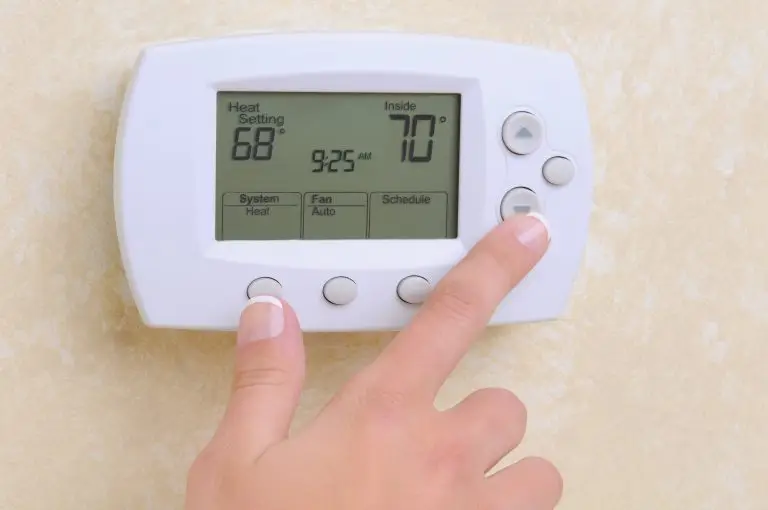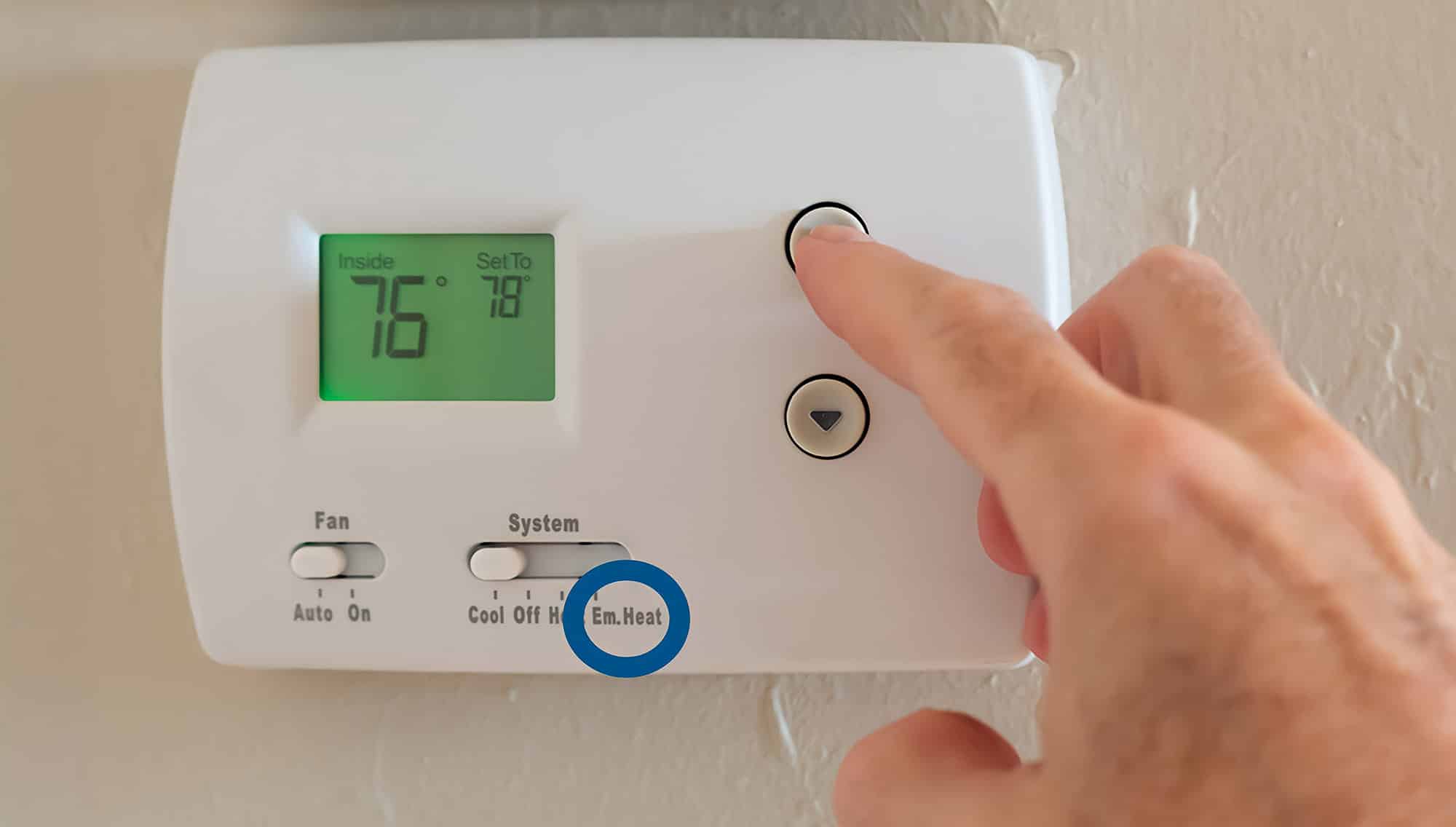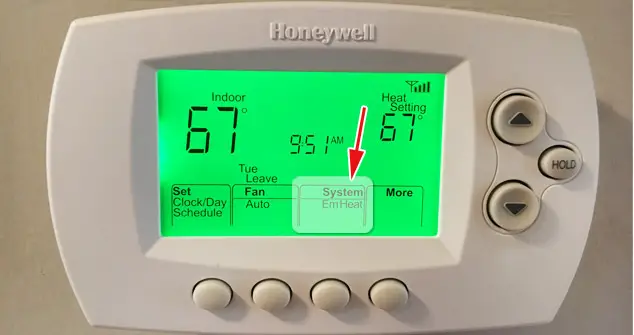Check Best Thermostat Pricing in Amazon
** As an Amazon Associate, I earn from qualifying purchases.
Emergency heat on a thermostat is a backup heating option. It kicks in when your primary heat source fails.
Understanding emergency heat is crucial for homeowners. This setting can keep your home warm during unexpected heating system failures. Often found in homes with heat pumps, emergency heat uses electric resistance heaters or a secondary heating source. Knowing when and how to use it can save you from freezing during winter.
So, what exactly is emergency heat, and how does it work on your thermostat? Let’s dive into the details to ensure you’re prepared for any heating emergencies.

Credit: charlottecomfortsystems.com
Introduction To Emergency Heat
Emergency heat is a term that often confuses homeowners. Yet, it’s an essential part of your heating system. Understanding it can help you stay warm during extreme weather. This section will explore what emergency heat is and why it’s important.
Definition
Emergency heat is a backup heating system. It activates when your primary heat pump fails. It’s also known as auxiliary heat. This system uses electric resistance heaters or gas. It ensures your home stays warm even if the main system breaks.
Importance
Emergency heat plays a crucial role during extreme cold. It ensures you have a reliable heat source. Without it, your home could become very cold. This can be dangerous during winter storms. Emergency heat provides peace of mind. It ensures your family stays safe and warm.
How Emergency Heat Works
Understanding how emergency heat works is crucial for homeowners. It helps in maintaining comfort during extreme cold. Emergency heat is a feature on your thermostat that activates a secondary heating system. This system ensures your home stays warm when the primary system fails.
Mechanism
Emergency heat kicks in when the outside temperature drops. The primary system, usually a heat pump, becomes less efficient in very cold conditions. The thermostat senses this inefficiency and switches to emergency heat. This secondary system typically uses electric resistance heating or a gas furnace.
The switch to emergency heat is often automatic. The thermostat monitors the performance of the heat pump. If the heat pump can’t maintain the set temperature, the emergency heat takes over. This transition ensures a continuous supply of heat.
Components
The main components of emergency heat include the thermostat, heating elements, and a control board. The thermostat is the central control. It monitors the temperature and activates the emergency heat when needed. The heating elements are the actual sources of heat. They can be electric coils or gas burners.
The control board manages the switching between the primary system and emergency heat. It ensures that the transition is smooth. Other important components include sensors and relays. These help in detecting temperature changes and activating the appropriate heating system.
In summary, emergency heat is a backup system. It uses different components to maintain warmth in your home. This system is essential for extreme weather conditions. Knowing how it works can help you prepare for cold winters.
When To Use Emergency Heat
Knowing when to use emergency heat on your thermostat is crucial. This feature can be a lifesaver during specific situations. It ensures you stay warm when your primary heating system fails. Let’s explore the key scenarios where emergency heat becomes essential.
Weather Conditions
Use emergency heat during extreme cold. When temperatures drop below freezing, your heat pump might struggle. In such cases, emergency heat provides the necessary warmth. This setting ensures your home stays comfortable.
System Malfunctions
Emergency heat is vital when your primary heating system fails. If your heat pump stops working, switch to emergency heat. This backup system keeps your home warm while you arrange repairs. It offers peace of mind during unexpected breakdowns.

Credit: craigheadelectric.coop
Benefits Of Emergency Heat
Emergency heat provides extra warmth during cold weather when the main system fails. It ensures your home stays comfortable and safe.
When winter hits and your regular heating system can’t keep up, emergency heat on your thermostat can be a lifesaver. This setting can provide immediate warmth and protect your heating system from potential damage. Let’s dive into the benefits of emergency heat and see how it can make your life easier during those freezing months.Immediate Heating
Imagine waking up on a cold winter morning to find your home is freezing because your heat pump is struggling. Emergency heat kicks in immediately, providing quick warmth. Instead of waiting for your regular system to catch up, you get instant comfort. This is especially useful during unexpected cold snaps. Emergency heat uses electric resistance heating, so it warms up your space faster than a heat pump. This quick response can make a big difference in your comfort and well-being.System Protection
Running your heat pump constantly during extremely cold weather can strain the system. Overworking it can lead to breakdowns or expensive repairs. Emergency heat can help take the load off your heat pump. It provides a backup, allowing your primary system to rest. By using emergency heat, you can extend the lifespan of your heating system. This means fewer repair costs and less stress for you. These benefits make emergency heat an essential feature on your thermostat. Have you ever faced a situation where your heating system couldn’t keep up? Share your experiences in the comments!Drawbacks Of Using Emergency Heat
Emergency heat is a backup heating system for your home. It can be very useful during extremely cold weather. Yet, it has some drawbacks that can make it less than ideal for regular use. Let’s explore these drawbacks further.
Higher Energy Costs
Using emergency heat can lead to higher energy bills. This system uses more electricity than your regular heating. It operates continuously to keep your home warm. This constant use increases your energy consumption. So, you will notice a spike in your energy costs.
Wear And Tear
Emergency heat puts extra strain on your heating system. It is not designed for long-term use. Running it often can cause parts to wear out faster. This leads to more frequent repairs and replacements. Your heating system’s lifespan may also be shortened. This means more expenses for maintenance and repairs.
How To Activate Emergency Heat
Activating emergency heat on your thermostat can be crucial. Especially during extremely cold weather. It ensures your home stays warm. Even if your heat pump fails. This section will guide you through the process. It will explain the necessary thermostat settings. And provide a step-by-step guide. Let’s ensure your home remains cozy.
Check Best Thermostat Pricing in Amazon
** As an Amazon Associate, I earn from qualifying purchases.
Thermostat Settings
Understanding thermostat settings is important. Most thermostats have a specific mode for emergency heat. This mode bypasses your heat pump. It uses the backup electric or gas furnace instead. Look for settings labeled “Emergency Heat” or “EM Heat.” This setting is typically used during extreme cold. Or when your heat pump is malfunctioning.
Step-by-step Guide
Follow these steps to activate emergency heat:
- Locate your thermostat. Ensure it is set to “Heat.”
- Find the “Emergency Heat” or “EM Heat” switch. It may be a button or a setting in the menu.
- Toggle the switch or select the setting. Your backup heating system will activate.
- Monitor your home’s temperature. Make sure it remains comfortable.
- Contact a professional for a heat pump inspection. Emergency heat is only a temporary solution.
Following these steps ensures a warm home. Even if your primary heating system fails. Always remember to switch back to normal mode. Once your heat pump is repaired.
Common Myths About Emergency Heat
Understanding emergency heat on a thermostat can be tricky. Many people believe myths that lead to confusion and misuse. Let’s debunk these myths and clarify the facts.
Energy Efficiency
Many think emergency heat uses less energy. This is false. Emergency heat consumes more energy because it bypasses the heat pump. It relies on electric resistance heating, which is less efficient.
Another myth is that using emergency heat will save money. In reality, your energy bills may rise. Emergency heat is meant for short-term use only. Regular heating modes are more cost-effective.
Usage Scenarios
Some believe emergency heat should be used during cold snaps. This is not true. Use it only when your heat pump fails. It is a backup, not a primary heating source.
Others think emergency heat is faster to warm your home. This is another misconception. It may not heat faster and can be less effective. Stick to regular settings for normal conditions.
There is also a myth that you should switch to emergency heat during power outages. This is incorrect. Emergency heat will not work without power. Only use it when your heat pump is down but you still have electricity.
Maintaining Your Heating System
Keeping your heating system in top shape is essential. Regular maintenance ensures efficiency and prevents unexpected breakdowns. It also extends the life of your system. Here are some key steps to maintain your heating system.
Regular Inspections
Regular inspections are crucial. Check your thermostat settings frequently. Ensure it switches between heating and cooling modes smoothly. Look for dust or debris around the unit. Clean filters monthly to keep air flowing freely. Listen for strange noises, which can signal problems.
Professional Servicing
Hire a professional to service your heating system annually. They check for issues you might miss. Professionals inspect and clean internal components. They also check for gas leaks in gas heating systems. Regular professional servicing can save you money in the long run.
By following these steps, you can keep your heating system running efficiently. Regular care reduces the risk of emergency heat usage. It also ensures a cozy home during the cold months.

Credit: www.watkinsheating.com
Frequently Asked Questions
Is It Ok To Run Emergency Heat?
Yes, running emergency heat is OK in extremely cold weather. Use it only when necessary to prevent system damage.
When Should I Use The Emergency Heat Setting On My Thermostat?
Use the emergency heat setting when your heat pump fails or during extremely cold weather. Ensure regular system maintenance for best performance.
What Is The Difference Between Emergency Heat And Regular Heat?
Emergency heat uses backup heating elements, activating when the primary system fails. Regular heat uses the primary heating system.
What Causes Emergency Heat To Come On?
Emergency heat activates when the primary heating system fails or outdoor temperatures drop too low. It ensures continued warmth.
Conclusion
Emergency heat on a thermostat is a backup heating option. Use it when your heat pump fails. It ensures you stay warm during extreme cold. Always know how to activate it. Familiarize yourself with your thermostat settings. This will help in urgent situations.
Regular maintenance can prevent system failures. Stay proactive and keep your home comfortable. Understanding emergency heat is essential for winter readiness. Keep these tips in mind. Your home will stay warm and cozy.
Check Best Thermostat Pricing in Amazon
** As an Amazon Associate, I earn from qualifying purchases.


